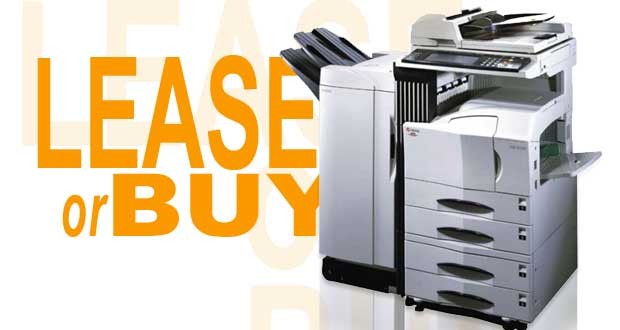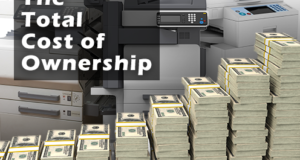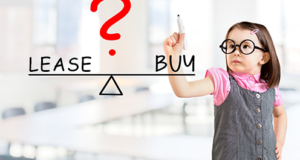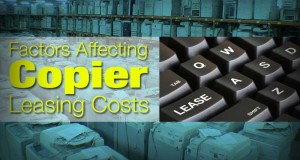When it comes time to lease a larger office copier, scanner or other multifunction device…or perhaps even two or three, you want to understand the advantages and disadvantages of a lease. And you WILL be presented with lease options. It’s the gold standard for how these machines are chiefly placed into business all over the world. When comparing whether to lease a copier vs. buy a copier, there are several considerations which may steer you in one direction or another. We’ll go through some key decision points and then summarize in a table below. If you just want to skip the reasoning and find that you work better with a clear, easy-to-read comparison grid, then go ahead and skip down—we promise not to be offended!
Who Owns the Copier?
Technically, in a lease, the copier is still owned by the dealer or company that issued the lease contract. A lot of times the company that offers you the copier holds the lease, but oftentimes it’s the manufacturer or a third party who takes care of that. In either case, you do not own the copier in a lease situation, and, in fact, you don’t ever own the copier until you buy it outright. Some leases are structured such that you can buy out the machine at the end of the lease term while other contracts (typically rare) structure the lease so that the buyout amount at the end of the lease is $0. What’s really important here, however, isn’t who owns the copier for the sake of ownership itself, it’s the tax implications of the fixed asset. See more on that in our next point.
Depreciating Assets and Deductible Expenses
There is a clear advantage to leasing when it comes to the depreciating asset of a large machine (or several large machines for that matter). With a lease, the entire copier lease payment is deductible immediately and, since you don’t actually own the device, it is not a depreciating asset. When you purchase a copier, printer, MFP or scanner, you have to capitalize the unit(s) as an asset and then depreciate them slowly over time according to the proper depreciation schedule.
Assets vs. Liabilities
Under a typical lease scenario, there is no need to record future lease payments as liabilities, meaning that your business doesn’t incur the additional liability of a very expensive machine (or series of machines). That will typically free up more available credit for use in expanding or maintaining your business.
Less is More
One thing that often gets overlooked with a lease vs. buy comparison is that you can often lease a much larger machine than you could afford to purchase outright. In many businesses that can lead to increased productivity, reduced downtime and greater efficiencies and opportunities. Leasing offers you the potential to acquire the use of a machine that you would otherwise not be able to afford or integrate into your operations.
Maintenance Woes Begone
Operating a sophisticated copier machine is no joke. The number of opportunities for a complex machine to present some technical issue is vast. While you can certainly entertain a service agreement apart from a lease, there is a symbiotic relationship between the two in many cases. This may take the form of negotiated rates, or simply a situation whereby a maintenance agreement is nearly always offered in conjunction with a lease agreement—whether it is separate or rolled into one. The bottom line is that the use of a service agreement is all but automatic with a lease and less negotiable (in terms of the “per click” rate) when you buy a machine outright.
Staying Ahead of the Curve
We alluded to the advantages of getting a bigger machine in a lease than you may have been able to afford, but there is one more angle on leasing that helps your business grow: Upgrades. At the end of a lease agreement you typically have the opportunity to roll the lease payments into a new device. That can result in faster print or copy speeds, greater capabilities, or simply the opportunity for you to upgrade and better match your growing business needs. When multiple machines are involved, it’s often a great strategy to stagger the lease agreements so that you are almost constantly upgrading a machine every year. In this way, many businesses have ensured they have a more frequent opportunity to upgrade or bolster the capabilities of their workflow.
And for those of you who like charts, here is one that outlines the basics fleshed out above:
|
Lease |
Buy |
|
|
Who Owns the Copier? |
Leasing company |
Your company |
|
Depreciating Asset/Deductible |
Deductible expense (lease) |
Depreciating asset |
|
Assets or Liability |
Not a capital expenditure |
Reduces cash flow/available credit |
|
Productivity |
Bigger/faster machine possible |
Machine size capped by capital |
|
Maintenance |
Virtually automatic |
Separate contract |
|
Futureproofing & Upgrades |
Regular pattern of upgrades |
Longer term use of existing machines |
 CopierGuide Copier and Multifunction Printer Leases and Reviews
CopierGuide Copier and Multifunction Printer Leases and Reviews





